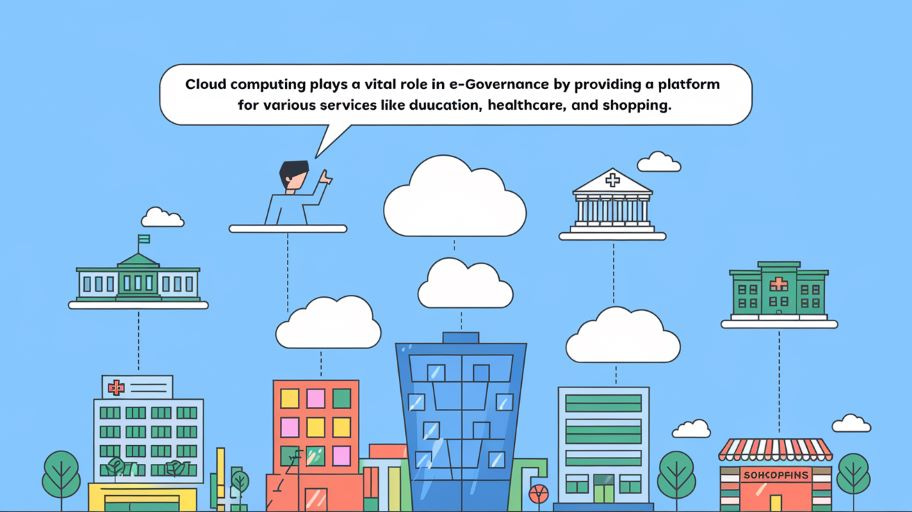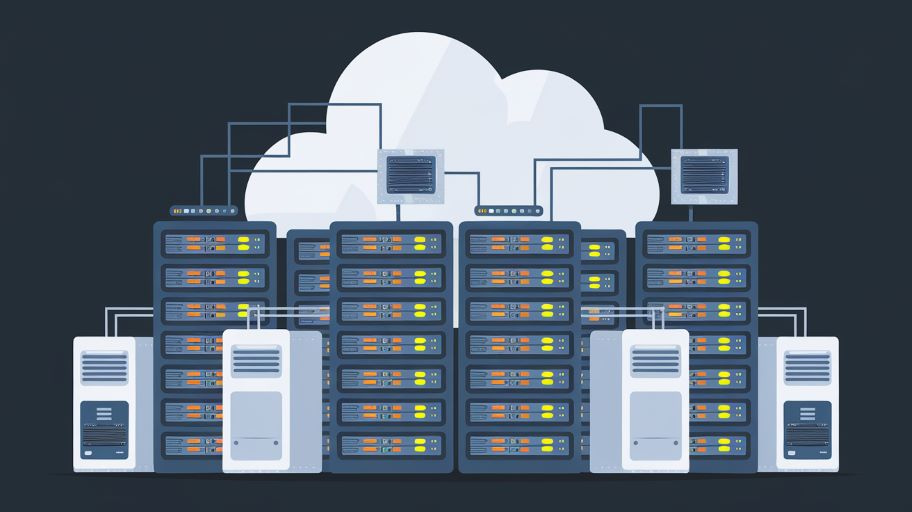In e-governance, cloud computing forms the basis of digital transformation. As a result, government functions and interactions with citizens are transformed. Providing scalable, secure, and efficient solutions is a key e-governance component.
People can easily access government information and services through cloud computing. In this way, good governance can be enhanced. In the digital age, governments need to stay relevant through cloud computing.
Introduction
Cloud computing enables governments to deliver services efficiently and cost-effectively through scalable and cost-effective IT solutions. Public services can be provided as a result of the centralized storage, management, and processing of vast amounts of data.
Cloud computing allows governments to reduce infrastructure costs, improve service delivery, and make citizens more accessible. Cloud platforms support collaboration across departments, ensuring seamless communication and data sharing. They also offer robust security measures to protect sensitive government and citizen data.
Governments can quickly adjust to shifting demands and needs by using technologies based on the cloud. It makes real-time data analysis possible for better policy execution and well-informed decision-making.
Initiatives like digital identity systems, smart cities, and e-portals for citizen interaction are all made possible by cloud computing. In public administration, it promotes efficiency, accountability, and transparency. In the end, it serves as a foundation for creating modern, adaptable, and interconnected governing systems.
Key Takeaways
- Cloud computing is a crucial component, providing scalable and secure solutions.
- The role of cloud computing is to enhance the delivery of government services.
- Cloud computing enables efficient and effective governance, making it necessary for governments.
- Cloud computing improves citizen engagement and interaction with government services.
- Integrating cloud computing offers numerous benefits, including enhanced security and improved accessibility.
- Cloud computing is transforming how governments operate, making it an essential part of digital transformation.
Foundations of E-Governance and Cloud Computing
Cloud computing transforms public services when it comes to electronic governance. The purpose of e-governance is to make government information and services easier to access. The cloud delivers services over the Internet, making them more flexible and cost-effective.
Combining cloud computing and digital governance changes government processes. Cloud computing helps make public services better and more focused on citizens. This mix makes services more open, transparent, and quick to respond to people’s needs.
What is E-Governance?
E-governance makes government services easier and more convenient. It uses technology for online services like renewing licenses and filing taxes. The goal is an open government where people can quickly get what they need.
Basic Principles of Cloud Computing
Cloud computing is all about being scalable, flexible, and cost-effective. It lets governments grow or shrink services without high costs, which is great for updating IT and improving citizen services.
The Combination of the Two Technologies
When digital governance and cloud computing combine, governments can offer new services. Cloud computing makes public services quicker and easier to use online or on mobile devices, allowing governments to focus more on what citizens need.
There are many benefits to combining governance and cloud computing. Some key ones are:
- Services are easier to get and more convenient.
- The government is more open and accountable.
- It can grow or shrink as needed.
- It saves money by cutting down on hardware and software costs.
The combination of digital governance and cloud computing is changing how governments work and serve citizens. Knowing about these technologies helps us see the good they can do.
What Role Does Cloud Computing Play in Digital Governance?
When you think about digital governance, you might ask what role cloud computing plays in e-governance. Cloud computing brings many benefits, like better scalability, reliability, and cost savings. These benefits help governments offer services more efficiently and effectively.
Cloud computing has several key advantages:
- Enhanced service delivery: Cloud computing lets governments provide services anytime, anywhere.
- Improved efficiency: It automates processes, reducing manual work and errors.
- Cost savings: It cuts upfront costs, helping governments use resources better.
Successful cloud computing projects in government show its power. Cloud computing can improve digital governance by making services more transparent and accountable.
In short, cloud computing is crucial for e-governance. It helps governments serve citizens better, more efficiently, and openly. Understanding cloud computing’s benefits helps governments make smart choices to improve citizens’ lives.
Key Components of Cloud-Based E-Governance Solutions
Cloud computing is key in digital governance. It offers many benefits, like making digital e-governance solutions more comprehensive and efficient. These solutions rely on three main parts: Infrastructure as a Service (IaaS), Platform as a Service (PaaS), and Software as a Service (SaaS).
(IaaS) in Government
IaaS (Infrastructure as a Service) gives government agencies a flexible and scalable infrastructure, letting them quickly deploy and manage resources. It also helps reduce costs and boost efficiency, making it crucial for e-governance solutions.
(PaaS) Applications
PaaS (Platform as a Service) is great for developing, running, and managing applications. It’s perfect for government agencies that need custom solutions. With PaaS, agencies can focus on developing applications that meet their needs without worrying about the Infrastructure.
(SaaS) Implementation
SaaS (Software as a Service) delivers software applications over the InternetInternet. This means agencies don’t have to install and maintain software themselves. Deploying new applications and services is easy, making SaaS a popular choice for e-governance solutions.
- How to Uninstall Fireshot Pro from Your Computer
- How Cloud Gaming is Revolutionizing the Video Game Industry
Understanding cloud-based e-governance solutions helps you see the benefits of cloud computing. It shows how these solutions can be efficient and effective.
| Component | Description |
|---|---|
| IaaS | Provides flexible and scalable infrastructure |
| PaaS | Offers a complete platform for developing and running applications |
| SaaS | Provides software applications over the internet |
Transforming Public Service Delivery Through Cloud Technology
Investigating the role of cloud computing in electronic governance is essential. It can change how public services are delivered, making them more efficient, accessible, and focused on citizens. Governments can offer better services, be more transparent, and engage citizens more with cloud computing applications.
Cloud computing brings many benefits. For instance:
- Improved scalability and flexibility
- Enhanced security and data protection
- Increased cost savings and resource optimization
- Better collaboration and information sharing
Some governments have used cloud technology to improve public services. They’ve created online portals, cloud-based data analytics, and digital platforms for community engagement. These efforts have improved public services and the citizen experience.
Using cloud computing applications helps governments create a better public service system. It’s not just about technology; it’s about creating a better future for citizens and communities.
| Benefits | Description |
|---|---|
| Improved scalability and flexibility | Cloud computing allows governments to quickly scale up or down to meet changing demands |
| Enhanced security and data protection | Cloud-based solutions provide robust security measures to protect sensitive citizen data |
| Increased cost savings and resource optimization | Cloud computing helps governments reduce costs and optimize resources, leading to better public services |
Security and Privacy Considerations in Cloud-Based E-Governance
Security and privacy are key when considering cloud computing for e-governance. Cloud computing offers secure and reliable access to data and apps, a big plus for government services.
To protect data, several steps can be taken. These include:
- Encrypting data both in transit and at rest
- Implementing access controls and authentication protocols
- Regularly updating and patching software and systems
Data Protection Measures
Data protection laws and compliance are vital for cloud e-governance. By following these laws and implementing strong measures, risks can be lowered, allowing people to enjoy the benefits of cloud computing in digital governance.
Compliance Requirements
Following laws and regulations is crucial for cloud e-governance. It ensures cloud computing for government services meets data protection and security standards.
Risk Management Strategies
Effective risk management is key for cloud e-governance. These strategies can keep sensitive information safe, allowing users to enjoy the benefits of cloud computing in digital governance.
Understanding security and privacy in cloud e-governance helps make better decisions. It ensures that cloud computing’s benefits are enjoyed while risks are minimized.
Cost Benefits and Resource Optimization
Cloud computing brings significant cost savings. It helps governments cut IT costs and use resources better. The importance of cloud computing in digital governance is evident in its ability to offer flexible, scalable services. This reduces waste and makes the best use of resources.
Cloud computing offers many benefits in governance, including lower upfront costs, reduced ongoing expenses, and more flexibility. Governments can easily adjust to changing needs without buying new equipment, which is key in digital governance, where needs can shift quickly.
Here are some ways cloud computing saves money and boosts efficiency:
- Less energy use and lower carbon emissions
- Better disaster recovery and ongoing operations
- Improved teamwork and productivity among agencies
Cloud computing helps governments build a more efficient, effective, and people-focused electronic governance system. Its importance in e-governance is enormous. Governments need to keep up and serve their citizens better.
Real-World Success Stories of Cloud Implementation in Government
Exploring cloud computing in digital governance is crucial. Real-world examples show how it transforms public services. Cloud computing helps governments deliver services better, saving money and engaging citizens more.
At the national level, cloud computing builds scalable, secure service platforms. Locally, it brings new solutions like online portals and mobile apps for services.
National Level Implementations
- Development of national portals for citizen services
- Implementation of cloud-based platforms for tax administration
- Deployment of cloud-based solutions for public health services
Local Government Success Cases
- Implementation of cloud-based platforms for municipal services
- Deployment of cloud-based solutions for public safety and emergency response
- Development of cloud-based portals for community engagement and participation
These stories prove cloud computing’s worth in e-governance. It helps governments serve citizens better, engage more, and save money.
Measurable Impacts and Results
| Implementation | Impact | Results |
|---|---|---|
| National Portal | Improved citizen engagement | 25% increase in online transactions |
| Cloud-based Tax Administration | Enhanced efficiency | 30% reduction in processing time |
| Cloud-based Public Health Services | Improved service delivery | 20% increase in vaccination rates |
These results show cloud computing’s value in e-governance. It leads to better service delivery, efficiency, and citizen engagement for governments.
Overcoming Implementation Challenges in Cloud-Based E-Governance
Beginning your journey with e-governance might face some hurdles. One big issue is resistance to change. However, the benefits of cloud computing are huge. With the right plan, you can overcome these obstacles.
Challenges like security worries, technical problems, and moving data can pop up. To tackle these, having a solid strategy is key. This might include:
- Doing detailed risk assessments to spot security threats
- Offering training and support for employees to ease the transition
- Setting up strong data migration and backup plans to cut downtime
By knowing the challenges and finding suitable solutions, governments can make cloud-based e-governance solutions work. This leads to better efficiency, lower costs, and more citizen involvement.
Conclusion
Looking ahead, cloud computing’s role in government will grow even more. Agencies see how cloud solutions can improve service delivery. They help streamline tasks and give citizens easy access to services.
With trends like IoT, big data, and AI, digital governance will become even stronger. This means governments can make more intelligent choices, use resources more effectively, and offer services tailored to each person. Investing in cloud tech, security, and digital skills is key to unlocking these benefits and meeting society’s needs.
FAQ’s
Cloud computing changes how governments work. It improves services, saves money, and works more efficiently. It gives governments tools to serve citizens better and run smoothly.
Cloud computing has many benefits. It allows services to proliferate, work reliably, and keep data safe. It also helps save money, letting governments focus on essential tasks.
Cloud computing fits well with egovernance. It uses Infrastructure as a Service (IaaS), Platform as a Service (PaaS), and Software as a Service (SaaS), which help governments better manage and grow their digital systems.
Cloud computing is suitable for government services. It saves money, makes services more straightforward, helps teams work together, and improves data management.
Cloud computing changes how governments serve the public. It makes them quicker, more efficient, and more focused on citizens. This leads to better services, citizen involvement, and brilliant resource use.
Critical cloud applications include citizen portals, online services, data management, team collaboration, and disaster recovery. These tools help governments update their work and offer better services to citizens.
Cloud computing is key to better government. It makes governments more flexible, efficient, and responsive to citizens. By using cloud tech, governments can use resources wisely, improve services, and engage citizens, leading to better governance and outcomes.



